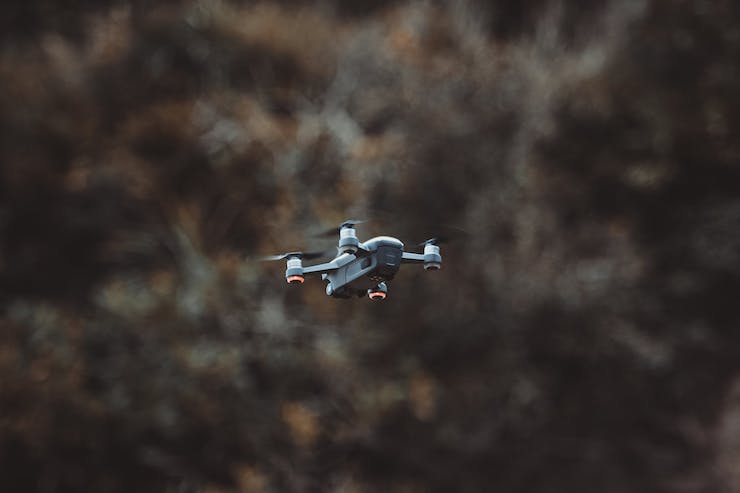Students Invent Drone Detection System for the US Military

Drones are being used widely throughout the United States of America. Police, fire, and emergency response departments use them to conduct missions. Commercial enterprises like TV broadcasters, film makers, inspection and construction crews, agriculturists, real estate agents and developers all rely on drones to preform jobs that have bettered their industries. This past holiday season saw more personal drones being bought than ever before as the hobby of flying drones also increases. The FAA estimates that there are close to 2 million registered drones in the United States of America, and that is only those that have been documented. With so many drones being used nowadays it is more important than ever for there to be an accountability of what is in the skies at any given moment.
For the majority of drone pilots, they fly their drones responsibly. This means avoiding restricted areas, keeping the drone within line of sight, and following safe practices set forth by the FAA. However there are always exceptions to this, and those rule breakers flying near airports or interfering with emergency procedures are what we hear about on the news. One such institution that is constantly battling rogue drones is the United States Navy. They often find drones spying on operation and taking pictures of sea vessels, mostly out of curiosity, but still a breach of security. As to tackle this issue Naval Sea Systems Command (NAVSEA) has sought help from a professor and his undergraduate student from Old Dominion University (ODU).
Located in Norfolk, Virginia ODU is one of the state’s largest universities. In recent years it has become well known for it’s advanced engineering programs. Professor Sachin Shetty has been assisting NAVSEA for a number of years now. He first received his BS in Computer Engineering from Mumbai University, in India. He then went on to get his MS in Computer Science from the University of Toledo, followed by a PhD in Modeling and Simulation at ODU. At ODU he runs the Cyber Security Center. In 2016 a freshman by the name of Michael Nilsen enrolled in one of Shetty’s cyber security classes. Majoring in electrical and computer engineering, Nilsen was taken by the work Shetty was teaching. “I thought it was the coolest thing ever,” he said, which led to the two embarking on a new project together.
As a student, Nilsen knew that he wanted to focus on the work that Shetty was involved in, so he contacted the professor and volunteered to be a research assistant in the Cyber Security Center. “Michael expressed interest in exploring that area of research and was very determined to learn and work without pay just to expand his knowledge,” Shetty said. “I was impressed by his inquisitiveness, his resourcefulness and his curiosity. You can teach the technical skills, but you can’t teach someone to be curious.” That curiosity along with the generous Old Dominion University Program for Undergraduate Research and Scholarship (PURS) grant allowed the two to build a device that could be used to detect a drone in the sky.
Now with the funding from the grant, Nilsen no longer had to volunteer his time, but was hired as an undergraduate research developer for the backpack sized device that could be used by NAVSEA to track intruding drones. With new drones constantly being developed, it was key to create a device that could identify any type of drone. Shetty was clear to point out though, “Our project is detecting, not taking them out of the sky,” that would be a job for the Navy to handle on their own.
The device that Nilsen and Shetty created has two versions. The first is about the size of a large cellphone, the second even smaller than that. Both connect to a laptop, making the entire detection system easy to transport. The device will pick up a signal from any drone and uses a machine learning algorithm to identify it. It relates the drone’s exact position as well as the make and model of the drone. Shetty said, “The benefits of using this machine learning technique is that no matter what types or models of drones made in the future, the technique can detect them. We didn’t want to create a technique that would be tied to a certain drone model and have to constantly change it.”
Shetty and Nilsen were invited to the Navy’s NSWC-Crane Division base in Indiana and then to the Yuma Proving Ground in Arizona to test the system over the course of several days. The tests were a huge success. When testing in Yuma Nilsen related, “About a kilometer out, I could tell that there was a drone present.” The devices was picking up a signal before a drone was even visible. For the Navy this has major implications. “Where the warfighters needs to use rapid drone detection technology, there is often no internet. They need a mobile, lightweight, and packable solution that works in a resource-constrained environment,” Shetty said. “Essentially, we are able to give the warfighter an RF classification toolbox on a device the size of a phone.”
Though Shetty and Nilsen, who is still only an undergraduate student, developed this device for the Navy to detect drones, they don’t see it be limited to military purposes. Shetty went on to say, “From an academic perspective we always saw this technology as a detection and identification capability that could not only be used for offensive purposes, but also defensive purposes. We can provide those real-time alerts and detect the presence of a drone within a matter of seconds. A geofence could be created to warn airport security that a drone is in the area.” The device could be used by emergency responders and could even lead to aiding the FAA in creating parameters for drones to be able to fly beyond line of sight.
|